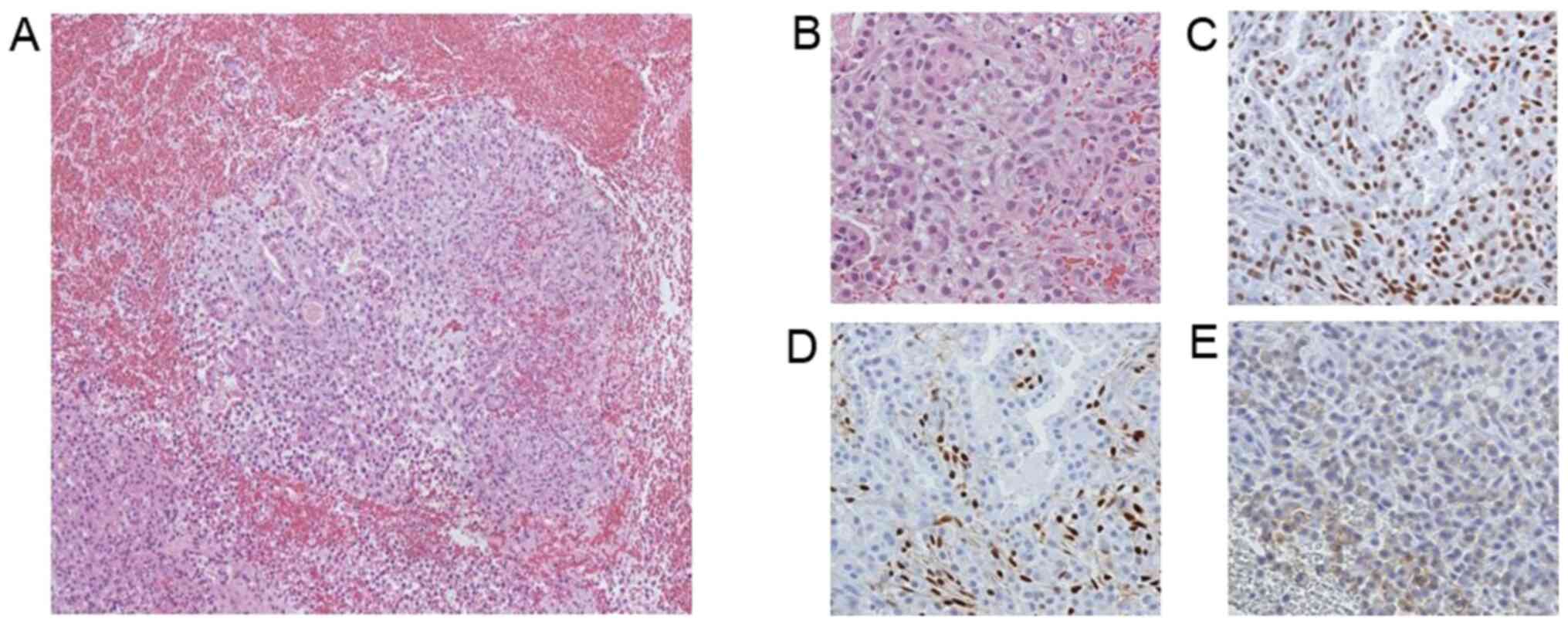
Uterine metastasis of lobular breast carcinoma under tamoxifen therapy: A case report
- Authors:
- Yuichiro Awazu
- Takeshi Fukuda
- Kenji Imai
- Makoto Yamauchi
- Mari Kasai
- Tomoyuki Ichimura
- Tomoyo Yasui
- Toshiyuki Sumi
-
View Affiliations
Affiliations: Department of Obstetrics and Gynecology, Osaka City University Graduate School of Medicine, Abeno‑ku, Osaka 545‑8585, Japan
- Published online on: October 28, 2021 https://doi.org/10.3892/mco.2021.2428
-
Article Number:
266
-
Copyright: © Awazu
et al. This
is an open access article distributed under the
terms of Creative
Commons Attribution License.
Metrics:
Total
Views: 0 (Spandidos Publications: | PMC Statistics:
)
Metrics:
Total PDF Downloads: 0 (Spandidos Publications: | PMC Statistics:
)
This article is mentioned in:
Abstract
Uterine metastases from breast cancer are uncommon and have rarely been reported in the previous literature. The present report describes the case of a 66‑year‑old female who developed uterine metastasis 23 years following the primary treatment of invasive breast cancer. Specifically, the patient experienced multiple bone metastases 14 years following primary treatment and had previously been treated with aromatase inhibitors followed by tamoxifen citrate. The patient presented with abnormal genital bleeding and was referred to the Gynecology Department of the Osaka City University Hospital (Osaka, Japan) 23 years following the primary treatment. The results of an endometrial biopsy revealed adenocarcinoma. Initially, it was difficult to differentiate between primary endometrial adenocarcinoma and metastatic adenocarcinoma from breast cancer. The results of pelvic magnetic resonance imaging demonstrated uterine myometrium enlargement and no endometrial thickness. Furthermore, an abdominal total hysterectomy, bilateral salpingo‑oophorectomy and a biopsy of the peritoneum were performed. The pathological examination of the resected uterus revealed adenocarcinoma, which proliferated diffusively in the cervical stroma, myometrium, cardinal ligament, bilateral adnexa, omentum and peritoneum. Immunohistochemical results revealed the positive staining of gross cystic disease fluid protein‑15, as well as negative staining for CD10 and E‑cadherin. Thus, the tumor was diagnosed as metastatic adenocarcinoma from the breast lobular carcinoma. The patient has since been treated with fulvestrant, toremifene citrate and tegafur, and the current patient survival duration is 2 years and 8 months. In conclusion, when patients with breast cancer undergoing hormonal therapy, such as tamoxifen, present with abnormal genital bleeding, future diagnoses should consider both endometrial cancer and uterine metastasis from breast cancer.
View References
|
1
|
Almagro E, González CS and Espinosa E:
Prognostic factors of early breast cancer. Med Clin (Barc).
146:167–171. 2016.PubMed/NCBI View Article : Google Scholar : (In Spanish).
|
|
2
|
Mazur MT, Hsueh S and Gersell DJ:
Metastases to the female genital tract. Analysis of 325 cases.
Cancer. 53:1978–1984. 1984.PubMed/NCBI View Article : Google Scholar
|
|
3
|
Watkins EJ: Overview of breast cancer.
JAAPA. 32:13–17. 2019.PubMed/NCBI View Article : Google Scholar
|
|
4
|
Kumar NB and Hart WR: Metastases to the
uterine corpus from extragenital cancers. A clinicopathologic study
of 63 cases. Cancer. 50:2163–2169. 1982.PubMed/NCBI View Article : Google Scholar
|
|
5
|
Harris M, Howell A, Chrissohou M, Swindell
RI, Hudson M and Sellwood RA: A comparison of the metastatic
pattern of infiltrating lobular carcinoma and infiltrating duct
carcinoma of the breast. Br J Cancer. 50:23–30. 1984.PubMed/NCBI View Article : Google Scholar
|
|
6
|
Arpino G, Bardou VJ, Clark GM and Elledge
RM: Infiltrating lobular carcinoma of the breast: Tumor
characteristics and clinical outcome. Breast Cancer Res.
6:R149–R156. 2004.PubMed/NCBI View
Article : Google Scholar
|
|
7
|
Perisić D, Jancić S, Kalinović D and
Cekerevac M: Metastasis of lobular breast carcinoma to the cervix.
J Obstet Gynaecol Res. 33:578–580. 2007.PubMed/NCBI View Article : Google Scholar
|
|
8
|
Razia S, Nakayama K, Tsukao M, Nakamura K,
Ishikawa M, Ishibashi T, Ishikawa N, Sanuki K, Yamashita H, Ono R,
et al: Metastasis of breast cancer to an endometrial polyp, the
cervix and a leiomyoma: A case report and review of the literature.
Oncol Lett. 14:4585–4592. 2017.PubMed/NCBI View Article : Google Scholar
|
|
9
|
Bray F, Ferlay J, Soerjomataram I, Siegel
RL, Torre LA and Jemal A: Global cancer statistics 2018: GLOBOCAN
estimates of incidence and mortality worldwide for 36 cancers in
185 countries. CA Cancer J Clin. 68:394–424. 2018.PubMed/NCBI View Article : Google Scholar
|
|
10
|
Giordano SH, Buzdar AU, Smith TL, Kau SW,
Yang Y and Hortobagyi GN: Is breast cancer survival improving?
Cancer. 100:44–52. 2004.PubMed/NCBI View Article : Google Scholar
|
|
11
|
Mariotto AB, Etzioni R, Hurlbert M,
Penberthy L and Mayer M: Estimation of the number of women living
with metastatic breast cancer in the United States. Cancer
Epidemiol Biomarkers Prev. 26:809–815. 2017.PubMed/NCBI View Article : Google Scholar
|
|
12
|
Li CI, Uribe DJ and Daling JR: Clinical
characteristics of different histologic types of breast cancer. Br
J Cancer. 93:1046–1052. 2005.PubMed/NCBI View Article : Google Scholar
|
|
13
|
Fu D, Zuo Q, Huang Q, Su L, Ring HZ and
Ring BZ: Molecular Classification of Lobular Carcinoma of the
Breast. Sci Rep. 7(43265)2017.PubMed/NCBI View Article : Google Scholar
|
|
14
|
Barakat RR: Tamoxifen and endometrial
neoplasia. Clin Obstet Gynecol. 39:629–640. 1996.PubMed/NCBI View Article : Google Scholar
|
|
15
|
Darb-Esfahani S, von Minckwitz G, Denkert
C, Ataseven B, Högel B, Mehta K, Kaltenecker G, Rüdiger T, Pfitzner
B, Kittel K, et al: Gross cystic disease fluid protein 15
(GCDFP-15) expression in breast cancer subtypes. BMC Cancer.
14(546)2014.PubMed/NCBI View Article : Google Scholar
|













